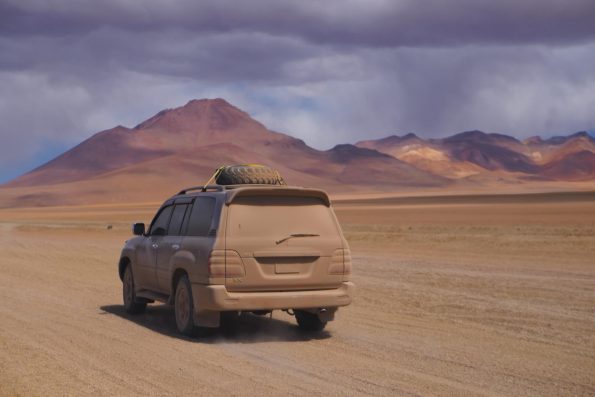The desert is probably the most inhospitable and dangerous places to break down. Dehydration can set in very quickly and many people have died trying to walk from their car to a nearby settlement. However, a dangerous situation is usually only because either more than one misfortune has occurred, or the driver has done something inadvisable. While it’s best to travel with another vehicle, travelling alone is sometimes the only way. Follow these tips when travelling through a desert or remote outback areas.
10 things to do before you leave for your trip through the desert
- Fill your car with fuel – fuel isn’t as easily available in remote areas
- Tell people what your plans are, including your projected route and arrival time
- Charge your cellphone and bring a car charger (if you have one)
- Download local maps to your smartphone’s sat nav so that even if you don’t have internet access, you can still see what’s around you; if you can’t do this, paper maps are a good backup. You should know how to navigate well
- Check that your spare tyre is properly inflated and that you have basic tools with you. A puncture repair kit in a can is an ideal backup. Carrying two spares is ideal if you will be gone for a while and you could also carry puncture repair kits.
- Take plenty of water and food plus warm clothes and/or blankets (desert areas are cold at night)
- Keep an emergency kit in the car – it will need a torch, shovel and first aid supplies
- A tarpaulin is useful for providing shade and keeping your car cool
- Do you know how to cool your engine down, change a tyre, unclog an air filter, etc?
- Do you know anything about the route you are taking and whether there are any inherent dangers?

Carrying an extra spare wheel could be a lifesaver if the road will be rough or you’ll be out of range for many kilometres.
Photo by Sean Thoman
What to do if you break down in the desert
- Stay calm – desert survival is challenging but not impossible (and you should be prepared from the list above)
- If you’ve become bogged down in sand, let some air out of your tyres to give them more grip. Dig out under the vehicle and you will probably be able to drive out. Don’t let too much air out, though.
- If you’re on a road with very little traffic, you may need to attempt a repair yourself.
- At night, you might be able to attract attention using a flare.
- Flag down another driver if you see one.
- In the heat of the day, stay in the shade. Lie under your car if possible
If you feel like you have to leave your car as you haven’t seen anyone in a while
Fight the urge to leave your vehicle – a helicopter can easily spot a vehicle, but it’s very hard to spot a person.
- Make a barrier for the road (e.g. a number of rocks or branches), plus spell out HELP in stones with an arrow pointing towards where you are (if you’re not visible from the road).
- Don’t leave in the heat of the day as the heat will dehydrate you very quickly and you won’t be able to carry enough water. At night you may be able to see the lights of a building in the distance. In the meantime, stay in the shade and conserve your water and energy. You will need to make a plan for being able to get back to your vehicle.
- If you have no cellphone reception, you could try walking to higher ground, but only if it’s very close. Again, doing this in the heat of the day is not advisable.
- Unless you can see an inhabited building less than a few minutes’ walk away, don’t leave your car. Setting off for a house in the distance can be the worst thing you can do as we are very bad at determining how far something is away. It might look a kilometre away but could be 8km away – a trek through a hot desert, the sun rapidly dehydrating you, is extremely dangerous. It’s easier for emergency services and other road users to find a car than a human.
- Always leave a note on your car to let someone know where you have gone. You can point the direction by making arrows with stones.
- Walking on the road is a better way of coming across someone than trying to hike across difficult terrain. You might have an idea of how far it was since you last saw signs of civilisation. At night, a fit person could realistically cover 4-6 km per hour on good terrain, so perhaps 25-40km in total, but not on sandy or rocky surfaces; in the heat of the day, you’ll run out of water in a matter of hours. If you’re on sand dunes, it could take you all night to cover just 5km.
- If you do decide to stay with your car, a last-ditch attempt would be to set fire to your spare wheel and hope that the smoke will attract someone
Every year, people die in desert conditions through not being prepared. If you are heading out into inhospitable territory, make sure you have a plan.
